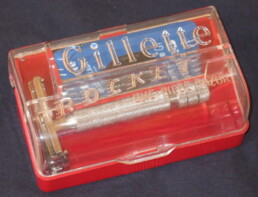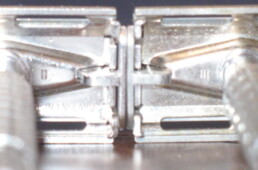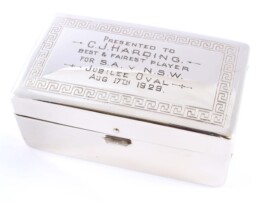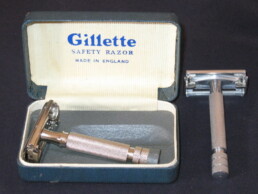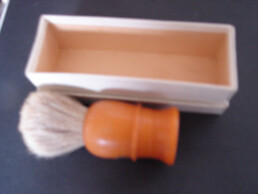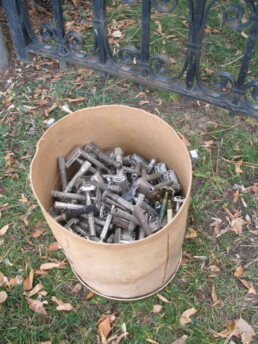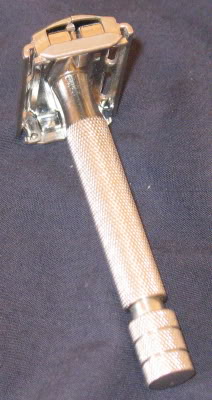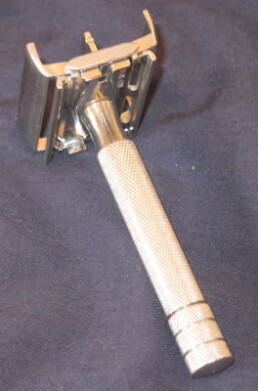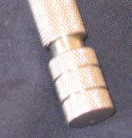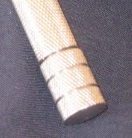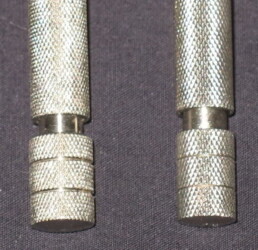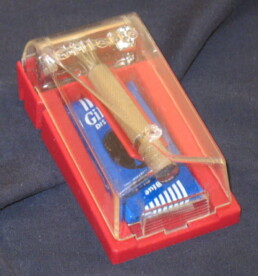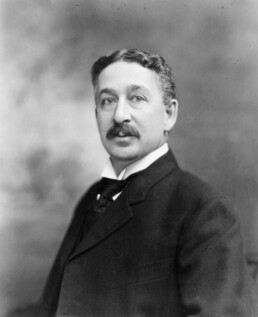Gillette Rocket ID and Information - Part Three
Once again I’m referring to a thread from a shaving forum – this time one where the images have been lost, despite being critical to the thread!
Fortunately I’ve tracked down the images and have recreated this reference on the wonderful Gillette Rockets below.
With acknowledgement to user ‘MTgrayling‘ who pulled this all together in the first place.
[This is Part Three of this post, see Part One here]
Flare Tip Rockets
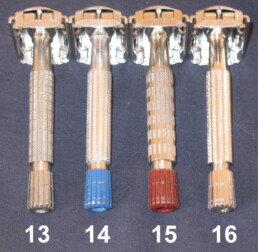
#13: The Flare Tip Rocket; this is perhaps the most common Rocket and is styled like the Flare Tip Super Speed.
These came in the same cases as the Parat, some clear/red some clear/white and a clear over white squarish case like the late model Super Speeds. Some were marked with a II symbol under head. These weighed 59 grams and have Brit. Pat. 694093 in the blade tray.
#14: Blue Tip Rocket; this is possibly the rarest of the Flare tip Rockets and is part of the pre-adjustable series like the colored American Super Speeds. These light shavers also have the aluminum handle like the American razor and weigh 47 grams. I’ve seen all of four of these shavers in my days searching. These had a I mark under head and the Brit. Pat. 694093.
#15: Red Tip Rocket; this is my favorite Rocket and one of the harder to find. Even a bit more aggressive than the Red Tip Super Speed this was part of the same pre-adjustable series like the Blue Tip. Those with the heaviest beards and those who like the closest shaves seek these out. These had a III mark under head. Brit. Pat. 694093. A heavyweight at 68 grams.
#16: TV Rocket; this is the only Rocket I know of that is Rhodium plated. I can’t explain why but they sure do shine. Perhaps these were made for a promotion like the Gillette Cavalcade of Sports and only made in 1958 like the TV Special. No one knows for sure, but these razors are very uncommon. Has the II symbol under head and patent pending or Brit. Pat. 694093 in the blade tray. Weighs the same as the standard flare tip at 59 grams.
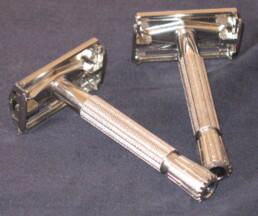
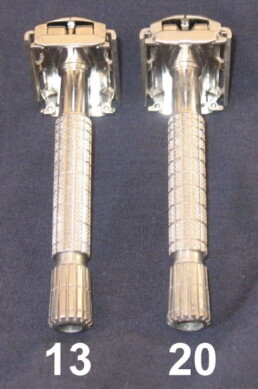
#20: Flare Tip Rocket; there were some of what I assume are newer vintage Flare Tips that have either an “A” or “S” stamped under head but only on a single side of the handle. What this represents is anyone’s guess, but these Rockets also have end caps like an American Super Speed. Along with the end caps these had a slightly different lower head profile. Brit. Pat. 694093 stamped in the blade tray, 58 grams.
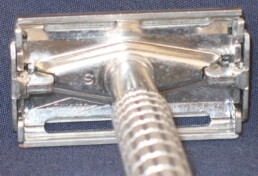

There are some odd differences in Rockets that I haven’t been able to explain. Some Rockets have teeth stamped under head into the one piece post and side plate unit. I have no idea of their purpose or why they were put there.
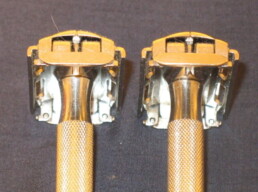
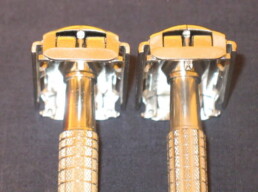
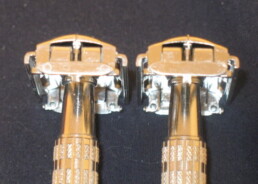
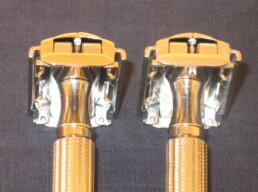
Follow on with the next instalment ...
The Story of One 'Bostonian'
I was in an antique store in Adelaide a few years ago and spotted a Bostonian case with some engraving on the top. Now I have a Bostonian and if it wasn’t for the engraving I may not have even picked it up.
But as you can see it was engraved as follows:
‘Presented to C. J. Harding Best & Fairest Player for S.A v N.S.W. Jubilee Oval Aug 17th 1929’
A mystery to be solved – who was C. J. Harding and what was he the best and fairest player for?
‘Presented to C. J. Harding Best & Fairest Player for S.A v N.S.W. Jubilee Oval Aug 17th 1929’.
Engraving on Case
After doing some research I discovered that according to an article in the August 17 1929 issue of The Register news-pictorial an interstate soccer match was held on that day at the Jubilee Oval in Adelaide between SA and NSW for the Australian Junior championship.
The match report from that evening’s issue of The Mail indicates that ‘an excellent exhibition of soccer was witnessed’ with NSW the victors 3 goals to 2. The Advertiser carries a picture of the game.
According to the report in The Mail, Harding scored the first goal for South Australia and ‘Harding was playing good football for South Australia, but his inside men failed to take advantage of his centres’. It seems that he was in the thick of it because it is also reported that ‘Harding was unlucky not to score from a hard drive across the goalmouth’.
So the mystery is cleared up.
The report concludes by indicating that ‘Trophies given for the best player on each side were won by Harding (South Australia) and Boddan (New South Wales)’.
After I posted this information in a shaving forum another member turned up the following from the Adelaide Advertiser of 25 Sept 1941:
CASUALTIES
PRIVATE ADVICES
Advice has been received by the wife of C. J. Harding that he died of wounds on September 20. He was married to Audrey, only child of Mr. and Mrs. E. S. Rush, of O.G. Hotel, Klemzig, on October 17, 1940, two months before he sailed for overseas. He was the only son of Mr. J. G. and the late Mrs. Harding, of Gilberton, and was educated at Pulteney Grammar School. He was a keen Soccer player, and before he enlisted was employed by News Ltd.
Follow this link for the original article.
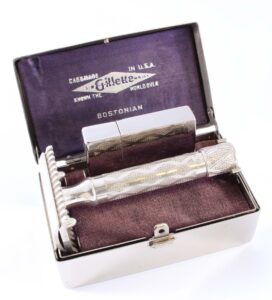 Of course this begged the question – was this the same C. J. Harding? The age seemed about right and he was described as being ‘a keen Soccer player’. It might have been written off a co-incidence except I recalled this this article which is from The Advertiser on the day before the 1929 game which outlined the teams, including:
Of course this begged the question – was this the same C. J. Harding? The age seemed about right and he was described as being ‘a keen Soccer player’. It might have been written off a co-incidence except I recalled this this article which is from The Advertiser on the day before the 1929 game which outlined the teams, including:
‘C. Harding (Pulteney Old Scholars) has had experience in senior league football and is the best wing man playing junior soccer to-day. He is fast, and his ball control and shooting make him a most useful man’
So with the school connection confirmed the C. J. Harding presented with the razor is almost certainly the same man who died of his wounds in September 1941. A little further digging turns up his military history.
Private Charles James Harding served with the 2/48th Battalion (Infantry) and was at Tobruk when he was wounded in action on 13 August 1941. He died of his wounds on 20 September 1941 in Egypt and is buried there at Alexandria.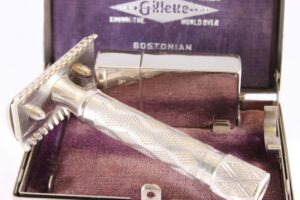
You can see a digital version of the records on-line here, on the second page of the records there is even a photo from his enlistment.
So there we have it. Unfortunately the antique store where I brought this from didn’t have any records of how they acquired this razor.
Obviously it never went to war from its condition, he probably left it with his new wife. What happened to her I don’t know. Did she remarry? Did she keep this razor until her death as a reminder of her husband? I’m not sure I’ll ever find out.
If you are ever at the Australian War Memorial you can see his entry in the Roll of Honour. I’ll certainly be stopping by next time I’m there and pay my respects.
Thanks to those who contributed to this story – it is much appreciated.
What tools do I need?
The fundamental tools of the trade are water (warm or cold although most people prefer warm), some sort of lubricant (usually shaving cream or soap) that can be used to form a lather, a brush to apply the lather, and a razor to remove the beard.
Soaps and creams
A lather is formed by the aeration/hydration of a shaving cream or hard shaving soap. A good soap/cream creates lather easily, lubricates and protects the face during the shave, and provides a pleasant aroma during the shave.
Soap making was an established craft in Europe by the seventh century, and were the first products used to create shaving lather. More than likely whatever hand/body soap was around the house was used to create a lather for shaving. Later, soaps specifically formulated for shaving were created. Hard soaps are generally poured into a container or formed into cakes.
A good soap/cream creates lather easily, lubricates and protects the face during the shave.
Shaving cream is a more recent phenomenon, only having existed for the past two hundred years or so. Creams have a soft consistency, often containing glycerin, naturally occurring saponified fats, and added scents.
Skin can react quite differently to different products, so what works well for one person may not work for someone else. In general, the more lubricating the material is, the better the shave will be. Of secondary concern is the scent of the product. These fall into several categories, including floral, woody, cologne-scented, etc.
Shaving Brushes
A shaving brush consists of a handle containing some sort of animal hair, usually boar or badger bristles. These animals are somewhat unique in that their hair absorbs water rather than repelling it. This allows water in the brush to mix with the shaving cream or soap to create a lather suitable for shaving. There is also a third kind of brush, one with synthetic fibre instead of hair. These brushes generally are cheapest and of lesser quality until very recently, but of use particularly for people who object to using animal products.
Why use a brush?
The bristles in the brush aerate/hydrate the water and cream (or soap) to form lather. This is used to lubricate and protect the face during the shave. In addition the bristles have a mild ex-foliating effect on the skin. Perhaps most importantly, the brush feels very good on the face – a very soothing feeling indeed when warm lather is applied.
What kind of brush should I get?
There are many types of brushes at many different price points. The handle should be comfortable to hold, and the bristles tightly packed. “Knot size”, or the diameter of the bristle mass at the handle end, is a measure of how large the brush is. Larger knot sizes make it easier to create large quantities of lather, but can be somewhat unwieldy on a small face. In the end, personal preference and aesthetics will determine what one person prefers versus another. A 22-26 mm knot size is a good starting point for many beginners.
Badger, boar, or synthetic?
Boar bristles are thicker, stiffer and hold less water than badger, and the brushes made from them are generally cheaper. Many men feel boar bristles are well suited to hard soap due to the stiffness of the bristles. Badger bristles, however, are much softer than boar and feel more luxurious on the face.
A badger shaving brush has been the standard for shaving brushes for centuries.
Synthetic bristles have been improving in recent years and are now more than shave worthy.
Grades of badger hair
There are several grades of badger hair, but unfortunately the nomenclature is not standardised, see more background here.
Generally, “pure badger” is the lowest grade, coming from the back of the animal. Pure badger is a dark colour, and is the least soft of the grades. “Finest (sometimes “best” or “super”) badger” is the middle grade, and has white tips with a dark band below. “Silvertip” is the highest grade, with very soft white bristles, also with a dark band below. Silvertip is harvested from the animal’s neck area.
Razors
Double edge razors
Double edge (DE) safety razors are the kind of razor your father and grandfather most likely used. The blade itself is a thin, flexible, two sided metal blade made to be used in a safety razor. These blades have a standard dimension and are commonly available very cheaply either on-line or in pharmacies or good grocery or convenience stores.
A safety razor holds the DE blade in place, and can be either fixed or adjustable in how much blade edge is exposed.
Common brands include the currently manufactured Merkur and Mühle-Pinsel, amongst an every increasing range of artisan brands, and vintage Gillette and Schick razors.
Safety razors were good enough for your father and grandfather – they will be good enough for you too!
Straight razors
Straight Razors (cut-throats) were among the first metal implements fashioned specifically for shaving. They are sharp, open metal blade with a handle to protect and store it. They need considerable skill to keep sharp enough for shaving through stropping and honing.
Cartridge razors
Disposable (fixed-head) and cartridge razors began to appear in volume in the early 1970s. Since then, there has been a proliferation of single, double, triple, quadruple, quintuple, and now sextuple-blade cartridge systems sold to the public.
Gillette Rocket ID and Information - Part Two
Once again I’m referring to a thread from a shaving forum – this time one where the images have been lost, despite being critical to the thread!
Fortunately I’ve tracked down the images and have recreated this reference on the wonderful Gillette Rockets below.
With acknowledgement to user ‘MTgrayling‘ who pulled this all together in the first place.
[This is Part Two of this post, see Part One here]
HD and LD Rockets
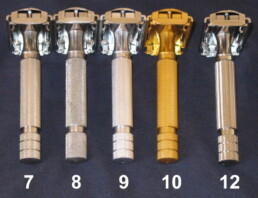
I realize I skipped #11, I can’t explain it. I have nothing against the number 11 that I know of, let’s call it a brain fart and not get all Freudian OK.
Edit: The aluminium handled #58 could go here.
#7: HD 500 Rocket/#59; this is the heavy duty Rocket sometimes referred to as the double ring, 500 or #59. This is many wet shaver’s favorite. It has a larger diameter handle and a few variants that we’ll see later. These hefty shavers came in clear/blue plastic cases that are different in the way they hold the razor horizontally by a tongue of plastic above the blade pack. They also came in a blue hard case and were then known as a #59. These can say either patent pending or Brit. Pat. 694093 in the blade tray some also have the II symbol under head. 71 grams for the full brass and copper version, 57 grams for the less common variant with aluminium handle.
#8: HD Rocket variant; this variation was for sale in Europe. Notice the plain knurled knob. Brit Pat. 694093 stamped in the blade tray and a II mark under head. This Rocket also has no made in stamped under head indicating it was probably made in Germany, 72 grams.
#9: Paperclip or LD (light duty) Rocket; this is an all aluminum HD Rocket except for the post, side plates and silo doors. It is much like the aluminum Rocket above, #1. This version is more common and has a nickname of the “Paperclip”, because it is said to be as light as…I’m sure you can guess. Stamped patent pending in the blade tray, weighs in at 34 grams.
#10: Gold aluminum LD; this is much like the LD above except for the obvious gold color and the aluminum silo doors. These were anodized gold I believe and aren’t plated. Very light, both the LD Rocket’s are said to weigh less than an ounce. Marked the same as the LD and at 29 grams this is the second lightest Rocket.
#12: #58; I’m not sure if this razor is a Rocket or an English Aristocrat so I’m including it here just because it’s damn gorgeous and one of my favorites. You can see it has much in common with the HD but has a richer knurling. These were cased in readily recognizable red hard cases. Below you can see two variations, one with a signature retaining ring the other without it. Some were stamped Patent Pending in the blade bed (1953 modles). Others were stamped Brit. Pat. 694093 and some carried the II marking. Weight varies between 68 and 72 grams. If there is a royal crown imprint on the top of the case lid, this is known as the No. 58 “Coronation” set and was made in 1953 to celebrate the Queen Elizabeth’s coronation.
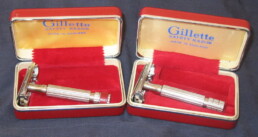
Follow on with the next instalment ...
My first vintage shaving brush
A long time ago in a land far away …
 OK, well maybe not THAT long ago, it was only 7 or 8 years or so ago that I saw this nondescript shaving brush on a large online auction site.
OK, well maybe not THAT long ago, it was only 7 or 8 years or so ago that I saw this nondescript shaving brush on a large online auction site.
The description was vague and as you can see, the photo was of little help. I was pretty certain though that it was a vintage, butterscotch Simpson shaving brush. I took a punt a put a modest bid on – and won! My first, vintage butterscotch brush 🙂
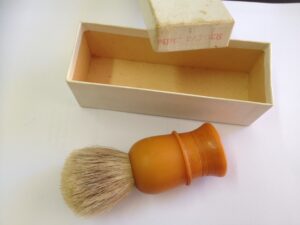 The butterscotch colour is the result of many years of UV radiation converted the outside, exposed layer of the catalin the handle is made of to phenyl alcohol with that distinct colour. The butterscotch brushes generally started life as a sort of cream, imitation ivory.
The butterscotch colour is the result of many years of UV radiation converted the outside, exposed layer of the catalin the handle is made of to phenyl alcohol with that distinct colour. The butterscotch brushes generally started life as a sort of cream, imitation ivory.
Not only was it a nice, butterscotch coloured brush, when you turned it over it had a label.
 In fact, that label looked familiar. I had not only a butterscotch coloured brush, but a vintage Simpson!
In fact, that label looked familiar. I had not only a butterscotch coloured brush, but a vintage Simpson!
Simpson brushes have a long and proud history, since 1919. The engraved lampe black markings are of the number ’41’ and ‘Pure Badger’ with the same written on the end of the box it came in.
After doing some research across some shaving forums one of the descendants of the original Simpson family, Gary Young, responded to my questions about this brush at The Shaving Room. Here is what he said:
‘1950s Nimmer Mill made Simpson 40 series brush. And yep, Peter is right that it isn’t one of our old ‘top end’ brushes. Back in the 50s a lot of the 40 series were sold in quantity to the ‘high street’ chemists – eg. Boots.
This looks like it was a ‘private’ sale as the ‘high street’ models were lampblacked with the Boots logo of the day.
The badger hair has ‘bleached’ over the years – normally due to being left on a bathroom window. But, as with our own hair, it tends to ‘whiten’ out over time, especially the coarser pure grade.
Nice little brush from one of our most busy decades so I reckon you had a good little find there.’
Gary Young, descendent of Simpson founder
I was very chuffed!
Unfortunately the knot was really not in great shape after being sun-bleached. So I sent the brush off to Simpson for a reknot, in ‘Pure’. The brush, with a new lease of life, remains in my regular rotation today!
Those cut throats look kinda cool, should I just get one of those?
It depends, sorry!
Straight razors, or cut throat razors, DO take more effort but can produce a better result.
The learning curve is longer and you will need to learn to strop your razor to keep the edge on it. You can also learn to hone it yourself, as most people do, or send it out for honing. There is certainly more to be mastered than simply swapping out one blade for a new one.
Straight shaving is not for everybody but it might be for you.
Having said all that, while straight shaving is not for everybody but it might be for you. Many people who have adopted shaving with a straight razor say they will never go back. Others alternate between using a straight razor and a safety razor. Most, but not all, straight shavers started with safety razors and subsequently moved to straights.
Gillette Rocket ID and Information - Part One
Once again I’m referring to a thread from a shaving forum – this time one where the images have been lost, despite being critical to the thread!
Fortunately I’ve tracked down the images and have recreated this reference on the wonderful Gillette Rockets below.
With acknowledgement to user ‘MTgrayling‘ who pulled this all together in the first place.
It all started after I found a 3 gallon tin of Gillette’s in October 2007. That’s 35 lbs. of vintage razors folks. What could come of such an event you say? A passion for all things Gillette for one, especially the lesser common and more solidly built English twist to opens known as Rockets, and a major draining of my liquidity for another.
That bucket contained over 250 razors, mostly Gillette’s, but not one of those ancient shavers was a Rocket. So in the twisted logic of a newly formed addict I theorized I needed more razors. I needed a Rocket!
Just over 12 months later and dealing completely through eBay I think I’ve found them all.
Rocket, what a cool name!
It all started after I found a 3 gallon tin of Gillette’s in October 2007. That’s 35 lbs. of vintage razors folks. What could come of such an event you say? A passion for all things Gillette for one, especially the lesser common and more solidly built English twist to opens known as Rockets, and a major draining of my liquidity for another.
That bucket contained over 250 razors, mostly Gillette’s, but not one of those ancient shavers was a Rocket. So in the twisted logic of a newly formed addict I theorized I needed more razors. I needed a Rocket!
Just over 12 months later and dealing completely through eBay I think I’ve found them all.
Rocket, what a cool name!
First of all what is a Rocket? We all know the official definition of the pointed missiles that pierce the sky on the way to space. As for razors it applies, in my opinion, to Gillette razors made in England that have a unique design where the twist to open knob shortens and recedes into the handle as the doors are opened, like a bolt and nut. American razors stay the same length whether the silo doors are open or closed.
This “Rocket gap” is a distinguishing feature that is easy to recognize.
The Rocket family encompasses a few other razors such as the Parat and Aristocrat Jr..
There are other differences such as a solid post and pointed side plate unit opposed to the folded post and soldered on blunt end caps common to American razors. This feature along with the internal mechanical design gives the more solid feeling most people report when talking of Rockets.
The Rockets also have a better polished silo doors and higher quality plating in my opinion.
Here’s a photo of the basic American and English razors for quick ID purposes.
American vs: English:
Left to Right:
40’s style SuperSpeed (US), 40’s style Rocket (UK); Flare tip SuperSpeed (US), Flare Tip Rocket (UK); TV SuperSpeed (US), TV Rocket (UK); Red Tip SuperSpeed (US), Red Tip Rocket (UK)
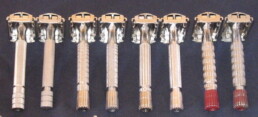
When were they made?
That’s a very good question since Gillette England did not date code their razors like Gillette in America so courteously did, as you can imagine this makes dating these razors fun and interesting.
The first Rockets were made post war and as early as 1948, if not sooner. Production lasted at least into the 60’s. Generally dates can be narrowed down by comparing the Rockets to similar looking American made razors, it’s anybody’s guess as to how accurate this method is though.
Onto the Rockets!
Rockets
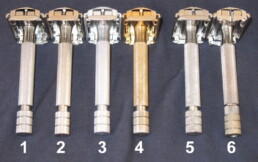
#1: 40’s style Rocket; this razor is the typical Rocket and is common in places like Canada, England where they were made and Australia. These razors came in the clear/red styrene case above and cardboard boxes like the early Super Speeds. These can say patent pending or have Brit. Pat. 694093 stamped in the blade tray, 63 grams in weight.
#2: This version of a Rocket is commonly known as a “Parat”. The name Parat comes from a German advertisement describing the razor as an aparat or apparatus. These were made in England if so marked under head or made in Germany if there is no stamp of origin. The best way to tell if you have a Rocket or Parat is to open the doors, if the knob is the same size as the handle it is a Parat, if the knob is slightly larger it is a Rocket. These say Brit. Pat. 694093 in the blade tray and have the II mark under head, 61 grams.
First of all what is a Rocket? We all know the official definition of the pointed missiles that pierce the sky on the way to space. As for razors it applies, in my opinion, to Gillette razors made in England that have a unique design where the twist to open knob shortens and recedes into the handle as the doors are opened, like a bolt and nut. American razors stay the same length whether the silo doors are open or closed. This “Rocket gap” is a distinguishing feature that is easy to recognize. The Rocket family encompasses a few other razors such as the Parat and Aristocrat Jr.. There are other differences such as a solid post and pointed side plate unit opposed to the folded post and soldered on blunt end caps common to American razors. This feature along with the internal mechanical design gives the more solid feeling most people report when talking of Rockets. The Rockets also have a better polished silo doors and higher quality plating in my opinion.
#3: Aluminum 40’s style Rocket; this Rocket is unique and made almost entirely of aluminum, or aluminium to the Brit’s out there, except for the post and side plates. I’ve only seen one other. This has patent pending stamped in the blade tray and weighs in at a slight 27 grams as the lightest Rocket.
#4: Gold Rocket; the Rocket came very thinly plated in gold. These are uncommon and I’ve never seen one that had more than 90% of the plating intact. They are somewhat delicate. Mine says patent pending and it weighs the same as a normal Rocket, 63 grams.
#5: Aristocrat Jr.; this is one of the better built Gillette’s in my opinion. It has a heavy 1/8”, 3mm, thick brass plate up top and is like a Rocket in every other way. I’ve heard these called #49 lately. These came in a dark vertical case that says Aristocrat Jr. on the inside. I’ve also heard they were cased in the same red/clear styrene case as the Rocket although I’m somewhat suspicious of these claims. Many people would put their old razor in the new razor case just to house it, or visa-versa. Just try to find the CD you’re looking for in the correct case in some peoples collections. BRIT PAT NO 403030 is stamped under head. At 71 grams this is one of the heaviest Rockets.
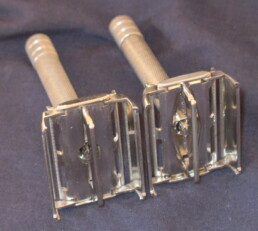
#6: Aristocrat Jr./#48; this uncommon razor could predate both the Rocket and Aristocrat Jr.. It has a knob that doesn’t recede into the handle but functions like an American Super Speed. It also has the 1/8” thick heavy flat brass plate that the blade rests on like the Aristocrat Jr.. More features of these razors are the lack of end caps and un-notched post reminiscent of a 1947 Super Speed, this is the only un-notched Rocket type that I know of. These share the same head design as the English Aristocrat #21. A Strange hybrid that came in either a white or blue Bakelite case. I think the blue cases were for sale in England and the white ones indicate it was for the Australian market. These have BRIT PAT NO 403030 stamped under head and weigh 62 grams.
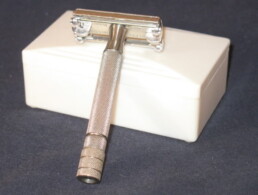
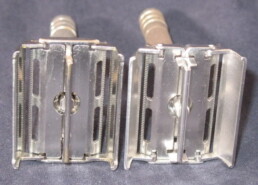
Follow on with the next instalment ...
I have a razor, brush, soap/cream and blades - do I need anything else?
If you are concerned about nicks get a styptic pencil or alum block. They help to constrict the blood vessels in the area. Simply take the styptic pencil and apply it directly to a bleeding cut or nick or rub the area with the alum block.
If you want to enjoy the experience or want to take a little more care of your skin get a post shave product – aftershave or moisturising balm. While not essential it does add to the enjoyment and helps to keep your skin in good shape – a worthwhile investment
You can spend very little on your shave, or a lot. It can remain a simple routine or become a daily ritual.
Many people also insist that you should finish off the shaving experience with cologne. There is an enormous range of scents for men as well as unisex scents.
You can also add additional razors, brushes, shave bowls and other accessories. In simple terms, you can spend very little on your shave, or a lot. It can remain a simple routine or become a daily ritual.
I got a kit with a sample of a whole lot of blades, which should I use first?
Blades samples are both good and bad.
Good in that you can try different blades, bad in that you don’t really know what to look for at the beginning of your shaving journey.
While opinions vary greatly about the best blade, and people have different favourites, the general view is that Merkur are rubbish, Feathers are the ‘sharpest’ and that Astra Superior Platinum, found in almost all sample packs, are probably a safe first blade.
… keep as many things constant as you can while you are learning.
The key when starting to use a safety razor is to keep as many things constant as you can while you are learning.
So don’t rotate through your razor sample pack using one of each blade in turn. Pick one blade, I’d suggest the Astra Superior Platinum, and use at least two of that same blade unless it really is horrendous on the first couple of shaves. This should give you around ten shaves. If you feel your shave is improving then stick with that blade for two more.
If the first blade you pick really is not working for you, change them until you find one that is OK and then stick with it until you have used four blades and have a few shaves under your belt.
History of Wet Shaving
Wet shaving at its simplest, is just that – shaving with water, a razor blade, and some sort of lubricant (soap, cream, gel, oil, etc.) on your face.
Men have shaved this way for centuries, starting early on with a sharp knife or stone, progressing to the straight (cut-throat) razor for many years.
In the late 1800s patents began to be issued for ‘safety razors’ as we know them. These originally held a single edge blade with King Camp Gillette filing a patent application for a safety razor using a disposable double-edge blade in 1901 which was granted in 1904, 15 November 1904 to be precise.
This patent revolutionised shaving and King Gillette popularised the safety razor.

Over time many modifications were made to this basic concept with additional ‘features’ such as twin and then multiple blades added, pivoting head mechanisms, lubricating strips, etc etc. These have ended up in the cartridge razor ‘systems’ and disposables we have now.
A closer shave can generally be had from a wet shave versus an electric razor. The ‘benefits’ of some of the other ‘advancements’ in razors over the years are far more dubious.
‘Why is it I always get my best ideas while shaving?‘
Albert Einstein
The ritual, scents, and connection to the past associated with using high-quality wet shaving products can also turn what is generally viewed as a chore into something pleasurable – that was certainly my experience.
Many men also feel their skin quality is improved by the ex-foliating nature of the wet shave and the moisturising nature of the products used.

